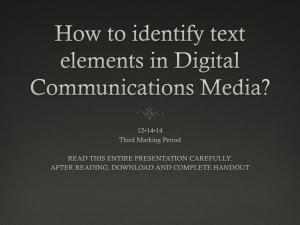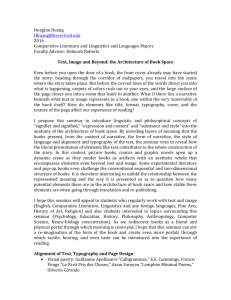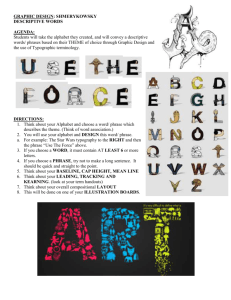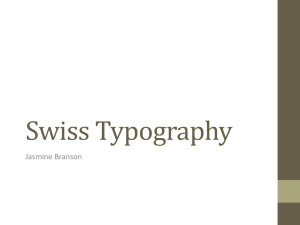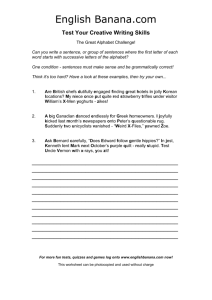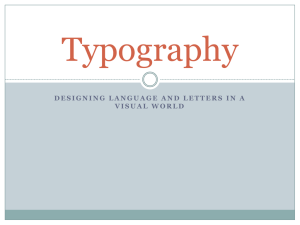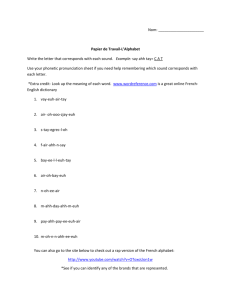SPIRIT Lesson:
advertisement
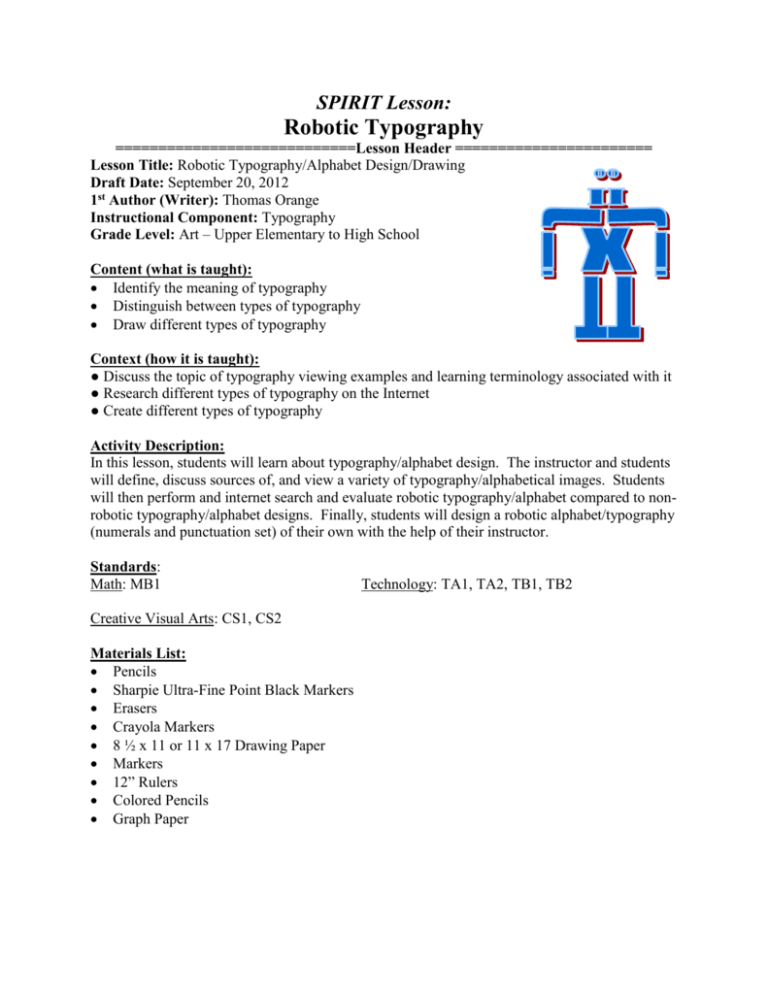
SPIRIT Lesson: Robotic Typography ============================Lesson Header ======================= Lesson Title: Robotic Typography/Alphabet Design/Drawing Draft Date: September 20, 2012 1st Author (Writer): Thomas Orange Instructional Component: Typography Grade Level: Art – Upper Elementary to High School Content (what is taught): Identify the meaning of typography Distinguish between types of typography Draw different types of typography Context (how it is taught): ● Discuss the topic of typography viewing examples and learning terminology associated with it ● Research different types of typography on the Internet ● Create different types of typography Activity Description: In this lesson, students will learn about typography/alphabet design. The instructor and students will define, discuss sources of, and view a variety of typography/alphabetical images. Students will then perform and internet search and evaluate robotic typography/alphabet compared to nonrobotic typography/alphabet designs. Finally, students will design a robotic alphabet/typography (numerals and punctuation set) of their own with the help of their instructor. Standards: Math: MB1 Creative Visual Arts: CS1, CS2 Materials List: Pencils Sharpie Ultra-Fine Point Black Markers Erasers Crayola Markers 8 ½ x 11 or 11 x 17 Drawing Paper Markers 12” Rulers Colored Pencils Graph Paper Technology: TA1, TA2, TB1, TB2 Asking Questions: (Robotic Typography) Summary: Students will discuss various vocabulary terms related to typography or alphabet drawing. Outline: View different samples of typography Discuss the use of typography learning key terms and types Activity: Students will be engaged in a class discussion about typography or alphabet drawing after viewing different samples of typography. The following questions should help guide the discussion. Question What is an alphabet? What is typography? What are typefaces? What are fonts? What are the different typeface classifications? What is typeface anatomy? What is Cap and x-height? What are decenders and ascenders? What are the typography/alphabet basics? What about the spacing around letters? Why is typography important? Answer A set of letters or symbols in a fixed order, used to represent the basic sounds of a language; in particular, the set of letters from A to Z, numbers 0 to 9 and punctuation. The arrangement of type/typography on a page. It is also the design and use of typography/alphabet as a means of communication or simply the art of print. Typefaces are a family of fonts. Fonts are one weight or style within that family. They are: serif, sans-serif, mono-spaced, cursive, fantasy, and script. These are the special characteristics that set one typeface apart from another. The height of the capital letters in the typeface and the height of the letter x. It tells you how tall the largest letters will be, and how big most lowercase letters will be. These are the portions of letters that go below and above the x-height line, but typically signify lowercase letters. They are the combination of size, spacing, and color. Spacing involves making necessary changes between and around letters. Typography makes an impact on what the reader sees and feels about the topic being discussed. Exploring Concepts: (Robotic Typography) Summary: Students will research typography or alphabet design viewing different robotic lettering projects. Outline: Research robotic typography or alphabet design using the Internet Print or prepare a power point viewing the different robotic lettering techniques Discuss the “likes” and “dislikes” about each styles as well as the techniques involved to create the style. Activity: Students will research robotic typography or alphabet design in its various forms (alphabet + robot works well). This can be done easily by using “Google” and typing in typography or alphabet design and then clicking on the appropriate images. One of the main focuses of student research should be finding various examples of robotic typography or alphabet design and what they show the viewer. As the images are viewed, the different types of robotic typography or alphabet designs should be printed, if possible, or at the least, create a student PowerPoint presentation. These should then be discussed with the class. To conclude, students will evaluate them as to likes and dislikes. Students should think about what are the advantages of creating visually appealing robotic typography or alphabets as they relate to other robotic visual arts and graphics. Instructing Concepts: (Robotic Typography) Robotic typography/alphabet design/drawing is a technique of creating visually appealing design and use of typography/alphabet as a means of communication. Typography/Alphabet Terminology Alphabet: A set of letters or symbols in a fixed order, used to represent the basic sounds of a language; in particular, the set of letters from A to Z, numbers 0 to 9, and punctuation. It is a set of symbols used in the writing system. It is a set of symbols used in the writing system. Typography: Typography is the arrangement of type/typography on a page. It is also the design and use of typography/alphabet as a means of communication. It is simply the art of print. Typeface: Typefaces are a family of fonts. Some common forms are: serif, sans-serif, monospaced, cursive, fantasy, and script. Fonts: Fonts are one weight or style within that family Typeface Classification: The different types of typeface classification are: serif; sans-serif, sans-serif; mono-spaced; cursive; fantasy; and script. Typeface anatomy: Typeface anatomy is the special characteristics that set one typeface apart from another. Cap and X-Height: This is the height of the capital letters in the typeface and the height of the letter x. It tells you how tall the largest letters will be, and how big most lowercase letters will be. Decenders and Ascenders: These are the portions of letters that go below and above the xheight line. These typically refer to lowercase letters. Typography Basics: Typography/alphabet basics are a combination of size, spacing, and color. Spacing Around Letters: Spacing involves making necessary changes letters. between and around letters. These include: kerning - space between individual letters; tracking space between groups of letters; leading - space between lines of type; measure - the length of lines of text; alignment - placing text to the left, right, centered or justified; ligatures - letters moved close together so that their anatomies are combined. Points to Remember: Choose your typeface design carefully. Pay attention to details. Take your time, don’t rush. The best typeface to use is what is appropriate for the time and the occasion. Make it look right and does it space well? Typography makes an impact on what the reader sees and feels about the topic being discussed. It is also created to communicate a message. So it must be clear, legible, artistic, attractive, and easy to read. Organizing Learning: (Robotic Typography) Summary: Students will create drawings of a complete original robotic fantasy typographical alphabet set including letters A – Z, numbers 0 to 9, and punctuation. Outline: Draw one complete original set of robotic fantasy typographical alphabet set Activity: In this activity, students will be given the task of drawing one complete original set of robotic fantasy typographical alphabet set including letters A – Z, numbers 0 – 9, and punctuation. They will follow acceptable standards and practices of lettering and typography design. Resource: http://www.jazjaz.net/2010/04/robot-alphabets-by-jimbot.html Understanding Learning: (Robotic Typography) Summary: Students will research and design a complete original set of robotic fantasy typographical alphabet set including letters A – Z, numbers 0 – 9, and punctuation. Outline: Formative Assessment of Typography Summative Assessment of Typography Activity: Students will complete written and performance assessments related to robotic typography and alphabet design/drawing. Formative Assessment: As students are working, ask yourself or your students these types of questions: 1) Do students understand the vocabulary related to typography and alphabet design? 2) Were the students able to understand and complete a complete of typographical alphabet including letters A – Z, numbers 0 – 9, and punctuation in the style requested? Summative Assessment: Students will complete the following writing prompts: 1) Explain what how the characteristics of robotic fantasy typographical alphabets differ from cursive typographical alphabets and provide an example of each. 2) Provide at least 5 different examples of robotic fantasy typographical alphabet. Students will draw samples of these 5 examples. Students can complete the following performance prompts: Provide students with the letter A of a set of robotic typography. The students will then design the remaining alphabet letters B – Z, numbers 0 – 9, and punctuation. Lesson Extension: 1. http://www.google.com/imgres?imgurl=http://cdn4.jazjaz.net/wp- 2. 3. 4. 5. 6. content/uploads/2010/04/Jimbot_Robot_Alphabets_thumb.jpg&imgrefurl=http://www.jazjaz.net/2010/04/r obot-alphabets-by-jimbot.html&h=520&w=640&sz=109&tbnid=ge71BDAIbxkqM:&tbnh=92&tbnw=113&zoom=1&usg=__YiZ5Ns4rFMtjaJy3WIuJInGColE=&docid=4nFtY2KL9fMZa M&hl=en&sa=X&ei=V-ZwUPLnEpKHqQGh0YDgBw&ved=0CB8Q9QEwAA&dur=0 http://www.better-cross-stitch-patterns.com/robot-alphabet.html http://mamarobot.blogspot.com/2011/02/robot-alphabet.html http://eliasklingen.deviantart.com/art/Robotic-Alphabet-301418165 http://xiao-ting.deviantart.com/art/Robotic-Animal-Alphabet-183846282 http://www.google.com/imgres?um=1&hl=en&sa=N&biw=1280&bih=546&tbm=isch&prmd=imvns&tbni d=1CX6RjzPksOBbM:&imgrefurl=http://firewireblog.com/2009/12/09/robot-alphabet-alphabotprint/&docid=ZL4la40K8EA9nM&imgurl=http://larryfire.files.wordpress.com/2009/12/il_fullxfull108627513.jpg&w=1000&h=1400&ei=putwUJi2FumkyQG9wYDIDA&zoom=1&iact=hc&vpx=590&vpy =59&dur=453&hovh=266&hovw=190&tx=67&ty=150&sig=114889959375927060578&page=1&tbnh=1 71&tbnw=122&start=0&ndsp=12&ved=1t:429,r:9,s:0,i:102
